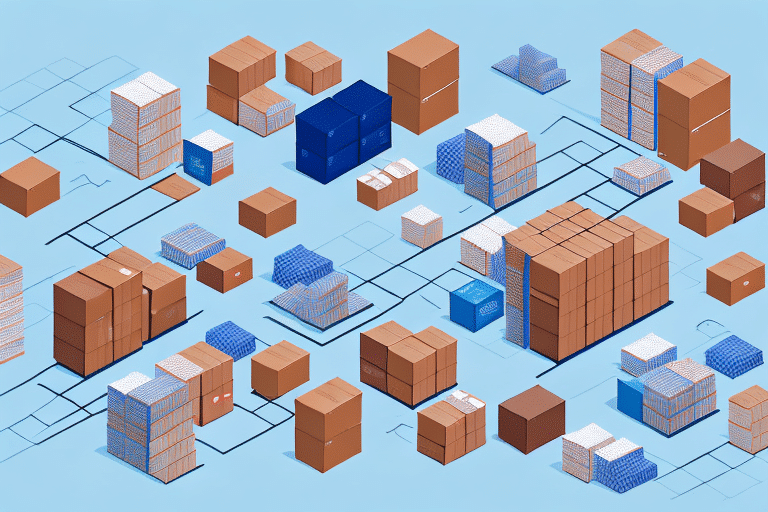Investing in Third-Party Logistics and Warehouse Fulfillment
Third-party logistics (3PL) and warehouse fulfillment services are pivotal in streamlining supply chains and giving businesses a competitive edge in today’s dynamic economy. As companies seek to focus on their core competencies, outsourcing logistics and warehousing has become increasingly popular to enhance efficiency and profitability. This article explores the fundamentals of third-party logistics, the benefits of outsourcing, key performance indicators, industry trends, and best practices for managing successful 3PL partnerships. Let’s delve into the world of 3PL and understand how it can transform your business operations.
Understanding the Basics of Third-Party Logistics
Third-party logistics (3PL) involves delegating logistics and supply chain management functions to specialized service providers. 3PL companies handle a variety of activities, including transportation, warehousing, inventory management, order fulfillment, and returns processing. Additionally, they offer value-added services such as packaging, kitting, labeling, and quality control. By acting as an extension of your business, 3PL providers allow you to concentrate on your primary business activities.
According to Grand View Research, the global 3PL market is expected to reach USD 1.3 trillion by 2027, growing at a CAGR of 8.1% from 2020 to 2027. This growth is driven by the increasing complexity of supply chains and the rising demand for logistics services across various industries.
Key Functions of 3PL Providers
- Transportation Management: Coordinating and managing the movement of goods from one location to another.
- Warehousing: Storing products in strategically located facilities to ensure timely delivery.
- Inventory Management: Monitoring and controlling inventory levels to meet demand without overstocking.
- Order Fulfillment: Processing and delivering customer orders efficiently and accurately.
- Returns Processing: Handling product returns and exchanges seamlessly.
Advantages of Outsourcing to Third-Party Logistics Providers
Outsourcing logistics to 3PL providers offers numerous benefits:
- Cost Savings: Eliminates the need to invest in warehouses, transportation fleets, and logistics staff. According to a study by Deloitte, companies can achieve up to a 15% reduction in logistics costs by partnering with 3PL providers.
- Scalability and Flexibility: 3PL providers can adjust their services based on your business needs, whether scaling up during peak seasons or optimizing costs during slower periods.
- Access to Expertise and Technology: Leverage advanced logistics technologies and industry expertise without the need for significant capital investment.
- Improved Efficiency and Service Levels: Benefit from faster delivery times, lower shipping costs, and enhanced customer satisfaction through streamlined operations.
Focus on Core Competencies
By outsourcing logistics functions, businesses can concentrate their resources and efforts on areas that directly contribute to their primary objectives, such as product development, marketing, and customer service. This strategic focus can lead to increased innovation, productivity, and overall business growth.
The Role of Third-Party Logistics in E-commerce and Online Retailing
The explosion of e-commerce has significantly boosted the demand for 3PL services. Online retailers require efficient order fulfillment, rapid delivery, and flexible returns handling to meet consumer expectations. 3PL providers offer the necessary infrastructure and technology to manage these demands effectively.
Enhanced Order Management
3PL providers utilize sophisticated order management systems that integrate with e-commerce platforms, providing real-time inventory visibility and streamlined order processing. This ensures accurate and timely deliveries, which are crucial for customer satisfaction.
Sustainable Logistics Solutions
With increasing consumer awareness about sustainability, 3PL providers are adopting eco-friendly practices. This includes optimizing routes to reduce carbon emissions, using sustainable packaging materials, and implementing energy-efficient warehouse operations.
Choosing the Right Third-Party Logistics Partner for Your Business
Selecting the appropriate 3PL provider is critical to the success of your logistics operations. Here are key factors to consider:
Experience and Expertise
Evaluate the provider’s experience in your industry and their ability to handle specific logistics challenges. A provider with a proven track record can offer valuable insights and solutions tailored to your needs.
Technology and Integration
Ensure the 3PL provider uses advanced technology platforms that can seamlessly integrate with your existing systems. This facilitates real-time data sharing, inventory tracking, and efficient communication.
Geographic Reach
If your business operates globally, partner with a 3PL provider that has a strong international presence. This ensures reliable delivery across different regions and access to local expertise.
Reputation and References
Research the provider’s reputation by reading reviews, testimonials, and case studies. Request references to gain insights into their performance and customer service quality.
Cost Structure and Transparency
Understand the provider’s pricing model to ensure it aligns with your budget and offers transparency. Look for a partner that provides clear pricing without hidden fees.
Evaluating the Costs of Third-Party Logistics Services
The cost of 3PL services varies based on factors such as service scope, order volume, and geographic coverage. Common pricing models include:
- Fixed Fees: Regular payments for specific services, offering predictability in budgeting.
- Variable Costs: Charges based on usage, such as per order or per shipment, providing flexibility as your business scales.
- Percentage-Based: Fees calculated as a percentage of the order value, aligning costs with sales performance.
When evaluating costs, consider the total cost of ownership, including indirect expenses like shipping charges, inventory holding costs, and labor expenses. Additionally, negotiate service level agreements (SLAs) to ensure you receive optimal value from your investment.
Best Practices for Managing a Successful Relationship with Your Third-Party Logistics Provider
Establishing a strong partnership with your 3PL provider is essential for achieving mutual success. Follow these best practices to ensure a productive collaboration:
Effective Communication
Maintain open and transparent communication channels with your 3PL provider. Regularly share updates on business changes, forecasted demand, and any potential challenges to facilitate proactive problem-solving.
Set Clear Expectations and Goals
Define specific objectives and performance metrics from the outset. This includes delivery timelines, order accuracy rates, and customer satisfaction targets.
Regular Performance Reviews
Conduct periodic evaluations of the 3PL provider’s performance against established KPIs. Use these reviews to identify areas for improvement and implement necessary adjustments.
Develop Contingency Plans
Work with your 3PL provider to create contingency plans for unforeseen events such as natural disasters, supply chain disruptions, or sudden spikes in demand. Having a plan in place ensures business continuity and minimizes operational risks.
Trends and Innovations in the Third-Party Logistics Industry
The 3PL industry is continuously evolving, driven by technological advancements and changing market demands. Key trends shaping the future of 3PL include:
Automation and Robotics
Automation technologies, including robots and automated storage systems, are enhancing warehouse efficiency and accuracy. These innovations reduce labor costs and increase throughput, enabling faster order fulfillment.
Artificial Intelligence and Machine Learning
AI and machine learning are being leveraged to optimize supply chain operations, predict demand patterns, and enhance decision-making processes. These technologies enable 3PL providers to offer more personalized and efficient services.
Blockchain Technology
Blockchain offers increased transparency and security in supply chain management by providing a decentralized ledger for tracking transactions and goods movement. This technology helps reduce fraud, errors, and delays in the supply chain.
Last-Mile Delivery Innovations
With the rise of e-commerce, there is a heightened focus on efficient last-mile delivery solutions. Innovations such as drone deliveries, autonomous vehicles, and crowd-sourced delivery models are transforming how goods reach consumers.
Sustainability and Green Logistics
Environmental sustainability is becoming a priority, with 3PL providers adopting green logistics practices. This includes using electric vehicles, optimizing routes for fuel efficiency, and implementing sustainable packaging solutions.
Key Performance Indicators for Measuring the Success of Your Third-Party Logistics Partnership
Measuring the effectiveness of your 3PL partnership is crucial for continuous improvement. Key Performance Indicators (KPIs) to track include:
- Order Accuracy: The percentage of orders fulfilled correctly without errors.
- Delivery Timeliness: The rate at which orders are delivered within the promised timeframe.
- Inventory Accuracy: The precision of inventory levels maintained by the 3PL provider.
- Customer Satisfaction: Feedback and ratings from customers regarding their delivery experience.
- Cost Per Order: The average cost incurred to process and fulfill each order.
By regularly monitoring these KPIs, businesses can identify strengths and areas for improvement, ensuring that their logistics operations remain efficient and aligned with their business goals.
How to Scale Your Business with Third-Party Warehousing and Fulfillment Services
Scaling your business involves expanding operations to meet increasing demand without compromising efficiency. 3PL services provide the necessary infrastructure and expertise to support growth:
Flexible Warehousing Solutions
3PL providers offer scalable warehousing options that can be adjusted based on your inventory needs. This flexibility allows businesses to expand their storage capacity without significant capital investment.
Efficient Order Fulfillment
As order volumes increase, 3PL providers can ramp up their fulfillment capabilities to ensure timely and accurate deliveries. This helps maintain customer satisfaction and supports business growth.
Market Expansion Support
With a global network of fulfillment centers, 3PL providers enable businesses to enter new markets more easily. They handle the complexities of international logistics, including customs clearance and local regulations.
Mitigating Risks and Ensuring Compliance in Your Third-Party Logistics Operations
Outsourcing logistics introduces certain risks that need to be managed effectively:
Cybersecurity and Data Protection
Ensure that your 3PL provider has robust cybersecurity measures in place to protect sensitive business and customer data from breaches and cyber threats.
Regulatory Compliance
Your 3PL partner should be well-versed in compliance requirements relevant to your industry, such as customs regulations, food safety standards, and consumer product safety laws. This ensures that your logistics operations adhere to legal standards, minimizing the risk of fines and legal issues.
Insurance and Liability
Verify that your 3PL provider carries adequate insurance coverage to protect against potential losses, damages, or liabilities arising from logistics operations.
Debunking Common Myths about Outsourcing to Third-Party Logistics Providers
Several misconceptions may prevent businesses from leveraging 3PL services. Let’s address some common myths:
Myth 1: Outsourcing is Only for Large Companies
Contrary to popular belief, businesses of all sizes can benefit from 3PL services. Small and medium-sized enterprises (SMEs) can access sophisticated logistics solutions and expertise that might otherwise be unaffordable.
Myth 2: Outsourcing is More Expensive
While there are costs associated with 3PL services, they often result in overall cost savings by eliminating the need for capital investments in logistics infrastructure and reducing operational expenses.
Myth 3: Loss of Control Over the Supply Chain
Partnering with a reputable 3PL provider can enhance supply chain visibility and control. Effective communication and integration with the 3PL’s systems ensure that businesses retain oversight and influence over their logistics operations.
Conclusion
Investing in third-party logistics and warehouse fulfillment services offers substantial benefits, including cost savings, enhanced efficiency, and the ability to scale operations effectively. By outsourcing logistics functions, businesses can focus on their core competencies, improve customer satisfaction, and drive growth. Selecting the right 3PL partner involves evaluating their expertise, technology, geographic reach, and cost structure. Embracing industry trends and best practices ensures a successful and resilient logistics strategy. As the logistics landscape continues to evolve, partnering with a reliable 3PL provider can be a strategic advantage that propels your business forward.






















